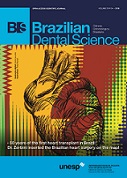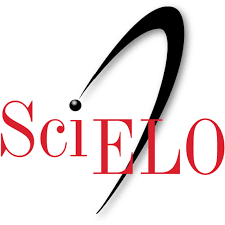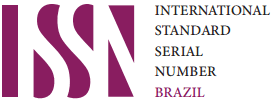Effects of different degrees of acidity and concentration of bleaching agents on human enamel mineral content and surface morphology over time
DOI:
https://doi.org/10.14295/bds.2018.v21i1.1493Resumo
Objective: The aim of this study was to evaluate the effect of pH and concentration of bleaching agents on the mineral content and surface morphology of human dental enamel for 14 days. Material and Methods: Eighty human central incisors were randomly divided into 8 groups (n=10): G1-7.5% hydrogen peroxide/pH=9.0; G2–9.5% hydrogen peroxide/pH=9.0; G3-7.5% hydrogen peroxide/pH=7.0; G4-9.5% hydrogen peroxide/pH=7.0; G5-10% carbamide peroxide/pH=5.0; G6-16% carbamide peroxide/pH=5.0; G7-37% phosphoric acid 15s (positive control); G8-no treatment (negative control). The mineral analysis of the bleaching gel collected was assessed by ICP-AES and surface morphology was observed by SEM. Results: Friedman and Dunn’s statistical test demonstrated significant differences among the proposed treatments (p<0.01). No significant difference was found among groups treated with hydrogen peroxide (G1, G2, G3, and G4) or among groups G5, G6 and G7 (p>0.01). However, the latter groups showed significantly higher values as compared to groups G1, G2, G3 and G4 (p<0.01). Conclusion: Alteration in enamel mineral content may not be influenced by concentration when bleaching agents with the same pH are compared. The most apparent alterations in mineral content and surface morphology may be noted when more acidic products are used. The daily mineral content measurement may not be influenced by repeated applications of bleaching agents.
Keywords
Dental bleaching; Mineral content; Enamel; Peroxide; Demineralization; pH.
Downloads
Downloads
Publicado
Como Citar
Edição
Seção
Licença
TRANSFERÊNCIA DE DIREITOS AUTORAIS E DECLARAÇÃO DE RESPONSABILIDADE
Toda a propriedade de direitos autorais do artigo "____________________________________________________________________" é transferido do autor(es) para a CIÊNCIA ODONTOLÓGICA BRASILEIRA, no caso do trabalho ser publicado. O artigo não foi publicado em outro lugar e não foi submetido simultaneamente para publicação em outra revista.
Vimos por meio deste, atestar que trabalho é original e não apresenta dados manipulados, fraude ou plágio. Fizemos contribuição científica significativa para o estudo e estamos cientes dos dados apresentados e de acordo com a versão final do artigo. Assumimos total responsabilidade pelos aspectos éticos do estudo.
Este texto deve ser impresso e assinado por todos os autores. A versão digitalizada deverá ser apresentada como arquivo suplementar durante o processo de submissão.




























